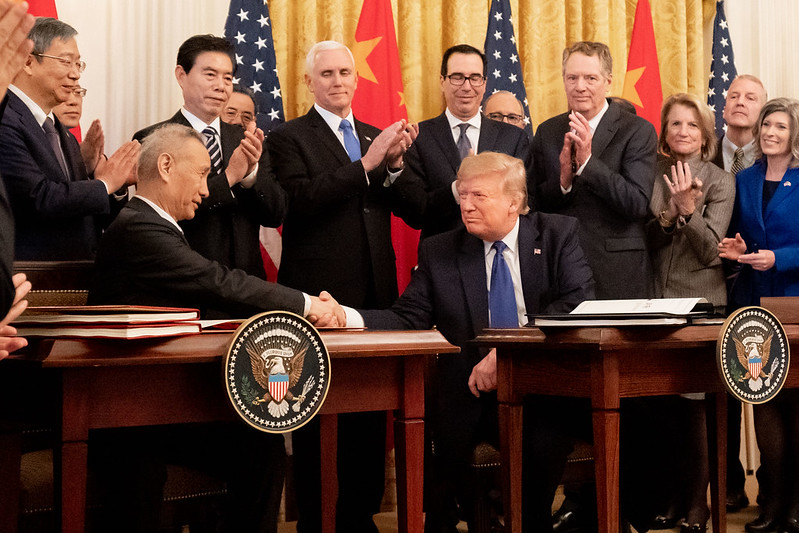
The much-touted U.S.-China “Phase 1” trade deal turned out to be a total bust. What should President Biden do now?
When future historians look back on January 2020, no doubt their focus will be on the emergence of the novel COVID-19 virus and the world’s initial response to it. What remains to be seen is whether anybody will even remember that there was a trade deal signed between the world’s two superpowers that same month.
Saturday marks the two-year anniversary of the U.S.-China “Phase 1” trade deal, which was signed by then-President Donald Trump and China’s Vice Premier Liu He at the White House. There was a lot of fanfare around the deal at the time, and the Trump administration certainly wanted to promote it as a turning point in U.S.-China relations.
Here at the Alliance for American Manufacturing, however, we were always skeptical about the deal. AAM President Scott Paul wrote the White House two days before the agreement’s signing to argue that far more needed to be done to rebalance U.S.-China trade.
The deal included nothing to address China’s most egregious trade practices, including massive industrial subsidies, state-owned enterprises, overcapacity, and predatory investment. Instead, it mostly centered on China buying more U.S.-made products.
In the two years since the signing, China has failed to meet even those commitments.

Now, it’s worth pointing out here that AAM was actually supportive of some of the Trump administration’s earlier actions on trade. Trump’s decision to implement Section 232 trade enforcement saved the U.S. steel industry at a critical time, for example. Section 301 tariffs issued on Chinese imports not only helped level the playing field for American producers, but managed to get senior Chinese leaders to come to the table to talk trade. That is no small feat.
The problem is that the deal the Trump administration eventually reached with China was completely inadequate, and China never abided by the terms of the agreement anyway. It’s not clear they ever intended to.
Which brings us to today. There’s now bipartisan recognition that the United States needs to get far more serious about China, and the myth that opening trade will solve all problems has been debunked. President Biden pointed to China when promoting infrastructure investment, noting that it was necessary to help win the competition of the 21st century. On Capitol Hill, the Senate passed a major competitiveness bill in a bipartisan vote last year; House leaders are said to be nearing an agreement on their version of that legislation.
Meanwhile, China’s government has only grown more bold in its human rights violations. Chinese leaders dismantled democracy in Hong Kong; in Xinjiang, they’ve been undertaking a cultural genocide against Uyghur Muslims and other ethnic groups. In response, Congress passed the Uyghur Forced Labor Prevention Act, which bans all imports from Xinjiang unless importers can prove their products were not made with forced labor.
But there’s more that both the Biden administration and Congress must do when it comes to China. AAM’s Scott Paul offered a handful of ideas in a statement on Thursday:
“First, we must invest in our own industrial capabilities and reshore critical supply chains. Investments in infrastructure, clean energy, and advanced technology programs that have been enacted or proposed are a good start.
“Second, our trade enforcement strategy must broaden. Now is not the time to remove tariffs on imports from China; they are not the cause of the episodic inflation we see today. Rather, we must sharpen and deploy new tools to defend against China’s unfair trade practices such as industrial subsidies, state ownership, overcapacity in key sectors, labor exploitation, non-enforcement of environmental regulations, and currency misalignment.
“Third, we must enlist our allies in these efforts, including in Europe, North America, and Asia. We can be stronger and more effective working together, but our allies must also do more to address China’s rampant trade cheating.
“Finally, we must be clear-eyed about Beijing’s intentions. Just as the notion that more trade would lead to more civil liberties in China has been decisively debunked, the idea that we should go easy on the CCP to gain climate goal cooperation is complete and utter nonsense…
“Now it’s time to enact a robust, forward-thinking policy response that will allow the United States not only to compete against China on the global stage, but to win.”
One thing is clear: China’s government is in it to win it. Chinese leader Xi Jinping and his team have a whole host of plans to dominate global industries in the coming years. It’s time for the United States to rise to the occasion, which will require far more than asking the Chinese to buy more stuff. It’s time for a fresh start, and a new strategy.
